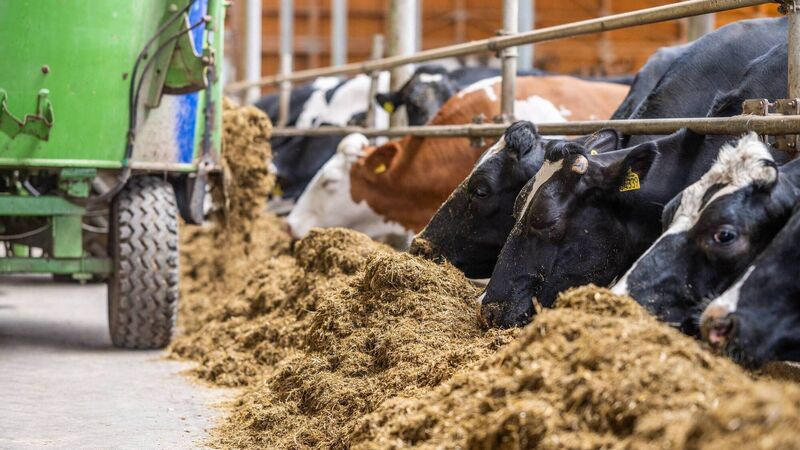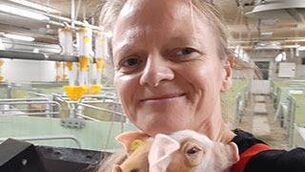Improving feed utilisation in winter diets

Analysing silage quality is crucial to understanding its fibre, energy and protein content so you can effectively balance the diet to achieve optimum health and performance.
It’s been a drastically different year this year, as we catch up with farms across the country. The west seems to have had a brilliant year of grass growth, and in fact, many areas of the midlands are reporting the same.
As we move east across the country, it was a far more difficult year in terms of grass growth due to a lack of rainfall, with some localised pockets experiencing severe soil moisture deficits.
Overall, there seems to be plenty of fodder stocks around the country, and animals have done well this year.
Winter feeding is a critical period for livestock performance, especially for growing and finishing animals. With rising feed costs and increased pressure on margins, farmers need to focus on maximising feed utilisation and achieving optimal daily live weight gain. Efficient feed use not only supports better animal performance, but also helps reduce waste, lower input costs and improve overall farm profitability.
Feed utilisation refers to how efficiently animals convert the feed they consume into productive outputs such as body weight gain. It is influenced by several key factors, including the quality of the feed, the balance of the ration, feeding management, and the overall health and environment of the animals.
High-quality, digestible feeds such as maize, barley and other high-energy ingredients provide more available nutrients, while a well-balanced ration ensures energy and protein are supplied in the right proportions to support optimal rumen function and animal performance.
Effective feeding management, such as regular feeding times, minimising waste, and providing enough barrier space, also plays a crucial role. Additionally, healthy animals housed in clean and well-ventilated conditions are better able to convert feed into growth.
This becomes especially important in winter, when cattle are housed and rely entirely on stored feedstuffs like silages and concentrates. During this period, maintaining or improving daily live weight gain depends heavily on getting all these factors right, as animals also face increased maintenance energy demands due to colder temperatures.
Testing the quality of silage is crucial to determine the dry matter digestibility (DMD). Silage with a DMD above 70% is ideal, promoting better weight gain. Lower-quality silage will necessitate additional concentrate feeding to meet nutritional requirements, especially for growing or finishing animals.
Analysing silage quality is crucial to understanding its fibre, energy and protein content so you can effectively balance the diet to achieve optimum health and performance. This year, especially, this is crucial to try capitalising on high beef prices.
High-quality silage will provide digestible fibre along with energy and protein to ensure healthy rumen function and reduce the reliance on concentrates.
It is unlikely farmers will be able to finish animals on grass silage alone, even with high-DMD silages. Some concentrate supplementation will be needed. But the better the quality of the silages being offered, the fewer concentrates are required to finish the animals.
Energy content should be a top consideration when purchasing feed. Feeds should be assessed on a cost per unit of energy (eg per megajoules of metabolisable energy) basis, not just price per tonne. This ensures you’re investing in feeds that deliver real nutritional value.
For example, a slightly more expensive feed may be more energy-dense and lead to better animal performance, ultimately making it more cost-effective.
When selecting feed ingredients, understanding their energy content is essential to ensure the diet meets animal requirements efficiently. Maize meal is one of the most energy-dense cereals, typically supplying around 13 MJ of ME/kg dry matter, making it ideal for boosting energy in high-performance rations.
Barley offers slightly less energy — approximately 12.5 MJ ME/kg DM — but is highly fermentable and supports rapid rumen microbial growth, making it useful for promoting weight gain when managed carefully to avoid acidosis.
Sugar-beet pulp, although slightly lower in energy at about 12 MJ ME/kg DM, is highly digestible and rich in fermentable fibre, supporting rumen health and improving the utilisation of other feeds. Its slow fermentation makes it a valuable complement to fast-fermenting starches like maize or barley.
Always purchase feed based on UFL content and ask about the ingredients in the mix to ensure there are no fillers. Don’t base your decision on price per ton.
Improving feed efficiency means getting more weight gain from every kilo of feed an animal consumes or improving the feed conversion efficiency. One of the key components in achieving this is ensuring the right type and amount of protein is supplied in the diet.
Protein will be low in quantity in a beef finishing diet but it plays a crucial role in supporting rumen microbial activity, which drives fibre digestion and energy release. It's important to strike the right balance between rumen-degradable protein and rumen-undegradable protein to optimise microbial protein synthesis and meet the animal’s requirements.
When protein is supplied in sync with available energy in the diet, it enhances feed conversion and supports higher daily live weight gain. However, overfeeding protein can be wasteful and costly.
The use of slow-release non-protein nitrogen sources, such as Optigen, can support nitrogen utilisation by providing a steady supply of ammonia for microbial growth, particularly when feeding high-starch diets. Optigen will work to maximise fibre digestion by increasing utilisable dietary protein supply.
Being a concentrated form of protein, it also creates room for more energy in the diet to optimise live weight gain. These are two crucial ways to get more from what feed is being fed and maximise feed efficiency.











